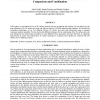Free Online Productivity Tools
i2Speak
i2Symbol
i2OCR
iTex2Img
iWeb2Print
iWeb2Shot
i2Type
iPdf2Split
iPdf2Merge
i2Bopomofo
i2Arabic
i2Style
i2Image
i2PDF
iLatex2Rtf
Sci2ools
CORR
2011
Springer
2011
Springer
Face Recognition using 3D Facial Shape and Color Map Information: Comparison and Combination
In this paper, we investigate the use of 3D surface geometry for face recognition and compare it to one based on color map information. The 3D surface and color map data are from the CAESAR anthropometric database. We find that the recognition performance is not very different between 3D surface and color map information using a principal component analysis algorithm. We also discuss the different techniques for the combination of the 3D surface and color map information for multi-modal recognition by using different fusion approaches and show that there is significant improvement in results. The effectiveness of various techniques is compared and evaluated on a dataset with 200 subjects in two different positions.
| Added | 19 Aug 2011 |
| Updated | 19 Aug 2011 |
| Type | Journal |
| Year | 2011 |
| Where | CORR |
| Authors | Afzal Godil, Sandy Ressler, Patrick Grother |
Comments (0)

